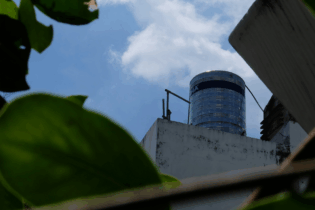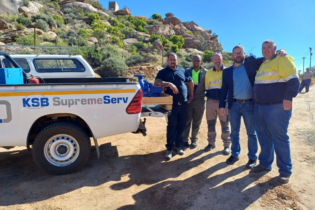The Hlabisa Bulk Water Supply Scheme is set to supply approximately 51 431 community members in the Hlabisa area, 18 606 community members in the Ezibayeni area, as well as the town of Hlabisa with a total demand of 4.17 Mℓl/d, Robert Moffat, Bigen Africa principal: Water & Sanitation and Willie Marais, Bigen Africa resident project engineer, tells Chantelle Mattheus.
“The scheme will serve households with bulk and reticulation networks and there is further capacity to extend the bulk infrastructure,” says Moffat, adding that considerable planning on a regional scale has been performed in the region, which to a large extent influenced the Hlabisa project. The project is located in the local municipality area of Hlabisa under uMkhanyakude District Municipality (UDM). The scheme covers the tribal authority areas of Mdletshe, Hlabisa Abasempembeni and Hlabisa Abakwahlabisa. The latter two areas are all inclusive whereas only the western portion of Mdletshe is included, that is excluding the eastern portion of Mdletshe, currently serviced by a scheme from Hluhluwe Dam (Mhlathuze Water). The total demand for both the Mandlakazi and Hlabisa areas is 7.26 million cubic metres per annum. Despite UDM being the client, Mhlathuze Water was appointed by the municipality as the implementing agent. Bigen Africa was then subsequently appointed by Mhlathuze as the consulting engineer on the project, responsible for the project’s business plan, tender administration, as well as the civil engineering on-site and site supervision and disbursement. In order to ensure community buy into the project and involve all stakeholders, a fully representative project coordinating committee (PCC) was also set up. Some of the representatives forming part of the PCC are from UDM, DWA, Hlabisa Local Municipality, councillors, PLO, consultants and so forth. Site meetings are held monthly between the implementing agent, contractor, PLO and consultant. “This creates a platform to discuss and report on key performance indicators and other issues relating to the project,” says Moffat. Sourcing supply According to both Marais and Moffat, there are a number of existing schemes within the area – specifically the Hlabisa Local Municipality – and although some are functional, some are dysfunctional too. The water source for this project is the adjacent Mandlakazi Regional Bulk Scheme under Zululand District Municipality who in turn gets their water from a private source. “The feasibility study refers to the fact that bulk water supply for Hlabisa will be sourced from the adjacent Mandlakazi Bulk Water Supply Scheme in Zululand District Municipality (DM). Both Mandlakazi Bulk Water Scheme and Hlabisa Bulk Water Scheme are being implemented concurrently by the Zululand DM and UDM respectively,” says Marais. Both men warn that the Hlabisa project is dependent on the timeous completion of the Mandlakazi portion of the bulk scheme where the two projects tie in. The scheme itself is designed to cater for a demand of 4.1 Mℓ/d, having used the following design parameters:- Bulk – 60 litres per capita per day
- Losses – 10%
The rugged rural conditions and changing weather conditions, including rain, also make access to the site a challenge at times.
Labour intensive Marais notes that the execution of the project has been purposefully based on labour intensive methods in order to provide employment opportunities to the local communities in these highly rural areas. “With the training envisaged, we hope to provide skills, which may lead to economic empowerment of those communities currently deprived thereof.” Some of the labour intensive tasks include clearing and grubbing of the trench routes, placing of bedding, laying of pipeline, collection of rocks for the filling of the gabion baskets, removal of topsoil, excavation and placing of bedding, among other tasks. As a result, from project commencement in 2009 to January this year, 2 965 people have been employed on-site, the majority of which (54%) have been male youths. According to Marais, the local labour has received informal site training from the material suppliers and contractors, with this training commencing prior to construction and still continuing. “The training is/was on trench excavation, manhole and valve chamber construction, pipe laying and jointing, pipe bedding and backfilling, concrete mixing and placing, to name just a few. Institutional Social Development (ISD) training was also provided on-site, relating to project management, financial/account management and water supply scheme management, among others. Progress to date While initially the project was to be implemented as a single venture with a number of emerging contractors working on it, due to financial constraints, the entire scheme was subsequently scheduled to be completed in different phases. Marais and Moffat both indicate that of the 96 km of pipes to be installed, 66 km have been installed to date, making this aspect 70% complete. Eight of the 14 reservoirs have been completed, with 24 of the 42 reservoir chambers having been completed, ensuring this aspect of the project was 57% complete at the beginning of the year. Additionally, 90 of the 197 air valve chambers have been completed (46% complete), with 14 of the 39 control chambers completed (36%). While the PED was completed in February 2008 and the design in September of the same year, construction still continues on a number of the contracts awarded to date. According to both Marais and Moffat, various “snags” on the uncompleted projects are still to be completed and all the reservoirs and approximately 13 km of pipes are as yet untested. This is despite initial construction deadlines starting in June 2010, due to difficulties experienced with all the contracts with the exception of the pipe supply contracts. “The appointment of capable implementing agents and an engineering consulting company to oversee the implementation of the project has been a success,” says Marais. He adds that the sections of work that have been completed and paid for are of acceptable standards. “Although final commissioning is not possible and some difficulties could be experienced, the implementing agent will ensure that the clients get value for money.” Currently, the revised expected completion dates are from September this year to February 2014 for the final contract which is still to be awarded with the tender process having been initiated in December 2012. The sustainability of the project outcomes, however, will be largely based on the operation and maintenance of the project once commissioned – which Mhlathuze has taken ownership of. “The future of the Hlabisa project depends on the full integration of existing infrastructure with the bulk system,” concludes Marais.






